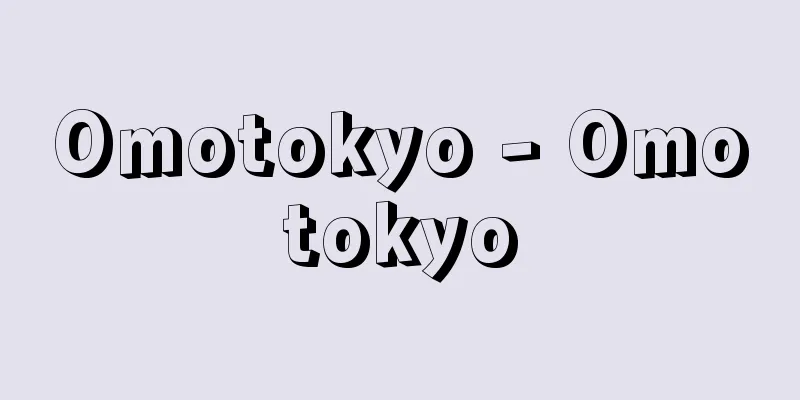Omotokyo - Omotokyo

|
A new religion based on syncretic Shinto. Its founders were Deguchi Nao and his son-in-law Deguchi Onisaburo. It was founded in 1892 (Meiji 25) in Ayabe, Kyoto Prefecture, by Deguchi Nao, a poor widowed carpenter, who was possessed by a god. Nao continued to write "Fudesaki," calling for the restoration of the world through the "Ushitora Konjin" (gold god) that had befallen her, and preaching the coming of the ideal world of "Miroku-no-yo." Nao initially belonged to Konkokyo, and spread the teachings through healing illnesses, but in 1899 she welcomed Ueda Kisaburo (later Deguchi Onisaburo) to form the Kinmei Reikai (Kinmei Spiritual Society), and established a doctrine based on syncretic Shinto. Onisaburo was born to a poor farming family near Kameoka, Kyoto Prefecture, and practiced asceticism on the sacred mountain of Takakumayama in his hometown, where he began healing illnesses using spiritual powers. Later, he joined the Inari Kosha in Shimizu, Shizuoka Prefecture, founded the Kodo Reigakukai (Imperial Way Spiritual Society) and preached there, but in 1900 (Meiji 33), he moved to Ayabe and married Nao's fifth daughter, Sumi (1883-1952). After coming into conflict with Nao, Onisaburo left Ayabe and became a Shinto priest in Kyoto, but returned to Ayabe to restore the faith's waning influence, and in 1908 he founded the Dai Nippon Shusaikai (Great Japan Shusai Association). The association expanded its influence nationwide, making full use of healing illnesses, prophecy, and collective spiritual asceticism to calm the soul and return to the spirits. In 1916 (Taisho 5), the name of the religion was changed to Kodo Daihon. During and after the First World War, under the guidance of the English literature scholar Asano Wasaburo (1874-1937) and others, the religion called for the realization of a divine government through the Taisho Restoration, and intellectuals and military personnel continued to convert. In 1921, the religion was subjected to the first round of suppression for violation of the lèse majesté law and the newspaper law, and was forced to change direction. Onisaburo wrote a new scripture, "The Tale of the Spiritual World," in which he preached that spirit is subordinate to the subject and that all religions have the same roots, and thus retreated and idealized the world-reforming doctrine that existed before the suppression. He also adopted Esperanto and began international activities, partnering with the Chinese religious charity organization Taoist Temple and the Red Swastika Society, and in 1925 founded the Jinrui Aizen Society. The following year, in 1926, the religion built Ten'onkyo in Kameoka as its headquarters, and made it a sacred place along with Baishoen in Ayabe. In 1934 (Showa 9), he formed the political organization Showa Shinseikai, which launched a fascist movement from below, but was considered dangerous due to its heretical doctrines that were incompatible with the Emperor system, and in 1935 was subjected to a second round of suppression for lèse majesté and violation of the Peace Preservation Law. Omotokyo was banned and its facilities were completely destroyed. After more than six years in prison, Onisaburo was released on bail during the Pacific War, but he secretly preached anti-war and peace, and devoted his later years to pottery. After the war, in 1946 (Showa 21), the sect was re-established under the name Aizenen, and in 1952 it reverted to the name "Omoto." During this time, Jinrui Aizenkai was re-established in 1949, and launched the World Federalism movement and the Religious Peace Movement. Religions that split off from Oomotokyo include Shinto Tenkokyo, Seicho-no-Ie, Sekai Kyuseikyo, Ananaikyo, and Jikoukyo (Jikoson). The headquarters is in Aratsuka-cho, Kameoka City, Kyoto Prefecture. There are 649 churches, 112 missionary stations, 4,825 teachers, and 168,969 believers (Religious Yearbook, 2014 edition). [Shigeyoshi Murakami] "Omoto 70 Year History Editorial Committee, ed., 'Omoto 70 Year History', 2 volumes (1964, 67, Religious Corporation Omoto)" ▽ "Murakami Shigeyoshi's Biography 'Deguchi Onisaburo' (1978, Sanseido)" [References] | | | | |Source: Shogakukan Encyclopedia Nipponica About Encyclopedia Nipponica Information | Legend |
|
習合神道系の新宗教。出口(でぐち)ナオとその女婿出口王仁三郎(おにさぶろう)を教祖とする。1892年(明治25)京都府綾部(あやべ)で、貧しい大工の未亡人出口ナオが神がかりして開いた。ナオは、自己にかかった「艮(うしとら)の金神(こんじん)」による世の立替え立直しを訴え、理想世界の「みろくの世」の到来を説いて、「筆先(ふでさき)」を書き続けた。ナオは初め金光教(こんこうきょう)に属し、病気治しを通じて布教したが、1899年上田喜三郎(のち出口王仁三郎)を迎えて金明(きんめい)霊学会をつくり、習合神道系の教義を整えた。王仁三郎は、京都府亀岡近郊の貧農の出身で、郷里の霊山高熊山に籠(こも)って修行し、霊力による病気治しを始めた。のち静岡県清水(しみず)の稲荷(いなり)講社に属して皇道霊学会をつくり、布教していたが、1900年(明治33)綾部に移って、ナオの五女すみ(1883―1952)と結婚した。王仁三郎はナオと対立して、綾部を去り、京都で神職となったが、衰えた教勢を回復するために綾部に戻り、1908年大日本修斎会をつくった。同会は病気治し、予言、集団的神がかり修行の鎮魂帰神などを駆使して全国的に教勢を拡大した。1916年(大正5)教名を皇道大本と改め、第一次世界大戦中から戦後に、英文学者の浅野和三郎(わさぶろう)(1874―1937)らの指導で、大正維新による神政実現を呼びかけ、知識層、軍人の入信が続いた。1921年不敬罪、新聞紙法違反で第一次の弾圧を受け、方向転換を余儀なくされた。王仁三郎は新教典『霊界物語』を述作し、霊主体従、万教同根を説いて、弾圧前の世直し的な教義を後退させ観念化した。またエスペラントを採用して国際的活動に乗り出し、中国の宗教慈善団体の道院・紅卍字会(こうまんじかい)と提携し、1925年人類愛善会を設立した。翌1926年、亀岡に天恩郷を建設して本部を置き、綾部の梅松苑とともに聖地とした。1934年(昭和9)政治団体の昭和神聖会を結成し、下からのファシズム運動を展開したが、天皇制と相いれない異端的な教義のため危険視され、1935年不敬罪、治安維持法違反で第二次の弾圧を受けた。大本教は禁止され施設は徹底的に破壊された。王仁三郎は6年余の獄中生活ののち、太平洋戦争中に保釈出所したが、ひそかに反戦平和を説き、陶芸に晩年の情熱を注いだ。戦後、1946年(昭和21)教団は愛善苑の教名で再発足し、1952年「大本」の教名に復した。この間、1949年に人類愛善会が再建され、世界連邦運動、宗教平和運動を展開した。なお、大本教から分立した宗教には神道天行居(てんこうきょ)、生長の家、世界救世教、三五(あなない)教、璽宇(じう)教(璽光尊(じこうそん))などがある。本部は京都府亀岡市荒塚町。教会数649、布教所数112、教師数4825、信者数16万8969(『宗教年鑑』平成26年版)。 [村上重良] 『大本七十年史編纂会編『大本七十年史』全2巻(1964、67・宗教法人大本)』▽『村上重良評伝『出口王仁三郎』(1978・三省堂)』 [参照項目] | | | | | |出典 小学館 日本大百科全書(ニッポニカ)日本大百科全書(ニッポニカ)について 情報 | 凡例 |
Recommend
Kasugakai
…An activist with friends in various fields, he w...
Blood bank
…an organization that stores blood and supplies i...
Triiodothyronine
…The thyroid hormones secreted from the follicles...
Longevity - Enjyu
〘 noun 〙 To extend one's lifespan. To prolong ...
Utsunomiya Fuyutsuna
...In the May 1333 (Genkō 3) defeat of the Chinze...
Holy people - Shoju
〘Noun〙 A Buddhist term. A multitude of bodhisattva...
fructication
…Single-celled organisms are represented by yeast...
Kazuo Hirotsu
Novelist. Born on December 5, 1891, in Yaraicho, ...
charamela
...wind instrument. A corruption of the Spanish a...
Tunga penetrans (English spelling)
…Other fleas that penetrate the tissues of their ...
Carex siderosticta (English spelling)
…[Tetsuo Koyama]. … *Some of the terminology that...
Kim Pyŏng-hun (English spelling)
1929‐ A writer from the Democratic People's Re...
Daihoonji Temple
A Shingon sect Chisan temple located in Mizomae-c...
Schwinger
…On this occasion, people dress up in various reg...
Enkaku - Engaku
It refers to a Buddhist saint. It is a translatio...









